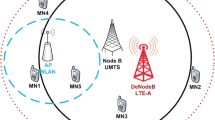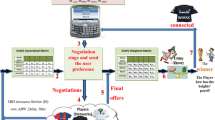Abstract
Newly emerging radio access technologies have produced a novel heterogeneous network environment. Wireless service operators should build the best service portfolio strategy for each user by focusing on the co-existence of multiple access networks and complex service combinations, while maximizing the overall network utilization. Web-based Decision Support System (web-based DSS) is one of the best ways of making service portfolios available to every user in a multiple access network environment. Service designers, customer relationship managers, and network engineers can build the best match relationship between services and networks to enhance user utilization. In addition, the easily accessible web-based DSS in an optimal heterogeneous network operation framework provides opportunities for designing new services. The network load and financial effect of newly designed services could also be analyzed and reshaped easily by testing the DSS functionality. Various mathematical tools have been developed for DSS to integrate different network domains. To demonstrate its applicability to the integration of network domains, we tested various service scenarios in a heterogeneous network environment and evaluated the versatile functions of web-based DSS.


















Similar content being viewed by others
References
Prytz, M., Karlsson, P., Cedervall, C., Bria, A., Karla, I.: Infrastructure cost benefits of ambient networks multi-radio access. In: Proceedings of IEEE Vehicular Technology Conference (2006)
Pittmann, F., et al.: Ambient networking: concept and architecture. Inform. Soc. Technol. (2005)
Sigle, R., et al.: Multiple radio access architecture. Inform. Soc. Technol. (2005)
Niedermeier, C., Schmid, R., Mohyeldin, E., Dillinger, M.: Handover management and strategies for reconfigurable terminals. In: SDR Forum Contribution (2002)
Haykin, S.: Cognitive radio: brain-empowered wireless communications. IEEE J. Sel. Areas Commun. 23(2), 201–220 (2005)
van Sinderen, M.J., van Halteren, A.T., Wegdam, M., Meeuwissen, H.B., Eertink, E.H.: Supporting context-aware mobile applications: an infrastructure approach. IEEE Commun. Mag. 44(9), 96–104 (2006)
van Kranenburg, H., Bargh, M.S., Iacob, S., Peddemors, A.: A context management framework for supporting context-aware distributed applications. IEEE Commun. Mag. 44(8), 67–74 (2006)
Fodor, G., Eriksson, A., Tuoriniemi, A.: Providing quality of service in always best connected networks. IEEE Commun. Mag. 41(7), 154–163 (2003)
Gazis, V., Alonistioti, N., Merakos, L.: Toward a generic always best connected capability in integrated WLAN/UMTS cellular mobile networks (and Beyond). IEEE Wirel. Commun. 12(3), 20–29 (2005)
Gustafsson, E., Jonsson, A.: Always best connected. IEEE Wirel. Commun. 10(1), 49–55 (2003)
Gazis, V., Houssos, N., Alonistioti, N., Merakos, L.: On the complexity of always best connected in 4G mobile networks. In: IEEE 58TH Vehicular Technology Conference (2003)
Kim, J.H.: Design of common resource management and network simulator in heterogeneous radio access network environment. J. Netw. Syst. Manag. 17(1–2), 137–156 (2009)
Clark, D., Partridge, C., Ramming, Ch.s., Wroclawski, J.: A knowledge plane for the internet. In: ACM Sigcomm 2003, Karlsruhe, Germany (2003)
Crowcroft, J., Hand, S., Mortier, R., Roscoe, T., Warfield, A.: Plutarch: an argument for network pluralism. In: Proceedings of ACM Sigcomm FDNA 2003 Workshop, Karlsruhe, Germany (2003)
Sollins, K.R.: Designing for scale and differentiation. In: Proceedings of ACM Sigcomm FDNA 2003 Workshop, Karlsruhe, Germany (2003)
3GPP TR 25.881: Improvement of radio resource management (RRM) across RNS and RNS/BSS
3GPP TR 25.891: Improvement of radio resource management (RRM) across RNS and RNS/BSS post-Rel-5
3GPP TR22.934: Feasibility study on 3GPP—WLAN interworking
3GPP TR23.234: 3GPP—WLAN interworking; system description
3GPP TR23.934: 3GPP—WLAN interworking; functional and architectural definition
Buddhikot, M., et al.: Design and implementation of a WLAN/CDMA2000 interworking architecture. IEEE. Commun. Mag. 41(11), 90–100 (2003)
EU IST 5FP Project ARROWS: Advanced radio resource management for wireless services. http://www.arrows-ist.upc.es
EU IST 5FP Project MonaSidre: Management of networks and services in a diversified radio environment. http://www.monasidre.com
EU IST 5FP Project CAUTION++: Capacity and network management platform for increased utilisation of wireless systems of next generation. http://www.telecom.ece.ntua.gr/CautionPlus
EU IST 6FP Project EVEREST: Evolutionary strategies for radio resource management in cellular heterogeneous networks. http://www.everest-ist.upc.es/
Luo, J., Mukerjee, R., Dillinger, M., Mohyeldin, E., Schulz, E.: Investigation of radio resource scheduling in WLANs coupled with 3G cellular network. IEEE Commun. Mag. 41(6), 108–115 (2003)
Vanem, E., Svaet, S., Paint, F.: Effects of multiple access alternatives in heterogeneous wireless networks. In: Proceedings of IEEE WCNC 2003, vol. 3, pp. 1696–1700 (2003)
Koo, I., Furuskar, A., Zander, J., Kim, K.: Erlang capacity of multiaccess systems with service-based access selection. IEEE Commun. Lett. 8(11), 662–664 (2004)
3GPP TR22.951: Network Sharing; Service Aspects and Requirements (Release 6)
3GPP TR23.851: Network Sharing; Architecture and Functional Description (Release 6)
Tu, Z.: Access selection in always best connected networks. Distributed Computing and Applications to Business, Tenth International Symposium on Engineering and Science (DCABES), pp. 248–251 (2011)
Schumacher, J., Dobler, M., Dillon, E., Power, G., Fiedler, M., Erman, D., De Vogeleer, K., Ramos, M.O., Argente, J.R.: Providing an user centric always best connection. In: Second International Conference on Evolving Internet (INTERNET), pp. 80–85 (2010)
Lampropoulos, G., Skianis, C., Neves, P.: Optimized fusion of heterogeneous wireless networks based on media-independent handover operations. IEEE Wirel. Commun. 17(4), 78–87 (2010)
Lahde, S., Wegner, M., Wolf, L.: Efficient network selection in heterogeneous communication scenarios using arbitration. IEEE International Symposium on a World of Wireless Mobile and Multimedia Networks (WoWMoM), pp. 1–6 (2010)
Kim, J.H., Oh, G.Y.: Design of a simulation test-bed for multimedia UCC traffic management in heterogeneous 3G/4G wireless networks. J. Netw. Syst. Manag. 18(2), 150–168 (2010)
Holma, H.: High-speed packet access evolution in 3GPP release 7. IEEE Commun. Mag. 45(12), 29–35 (2007)
Author information
Authors and Affiliations
Corresponding author
Appendices
Appendix 1
The minimization problem is stated as follows:
Minimize the total cost \( T(u_{1}, u_{2}, \ldots, u_{N} ) = \int\nolimits_{0}^{{u_{1} }} {f_{1} (u)du + \cdots + \int\nolimits_{0}^{uN} {f_{N} (u)du} } \) subject to the constraints \( u_{1} \ge 0, \ldots, u_{N} \ge 0 \) and \( u_{1} + u_{2} + \cdots + u_{N} = C \). Because the domain is compact, the total cost function has the minimum in its domain. The Karush–Kuhn–Tucker conditions require that there are constants \( \eta_{1}, \ldots, \eta_{N}, \lambda \) such that for \( k = 1,2, \ldots, N \),
and \( u_{1}^{*} + \cdots + u_{N}^{*} = C \). Therefore, if \( u_{k}^{*} > 0 \) for all \( k = 1,2, \ldots, N \), then \( f_{1} (u_{1}^{*} ) = f_{2} (u_{1}^{*} ) = \ldots = f_{N} (u_{N}^{*} ) \).
Appendix 2
We will prove that V(t) converges to zero as the time t approaches infinity.
Let \( A_{ij} : = c_{ij} (f_{i} (u_{i} ) - f_{j} (u_{j} )) \). The total traffic \( u_{1} + u_{2} + \cdots + u_{N} \) is conserved over time because
Because A ij = A ji and the marginal costs functions are increasing, we have
which implies that V(t) always decreases unless the traffic distribution (u 1(t), …, u N (t)) is not in a unique equilibrium state. Because V(t) is bounded below, we should have \( \dot{V} \to 0 \) as t → ∞. However, \( \dot{V} = 0 \) if and only if \( \dot{u}_{i} = 0 \) for all i = 1, …, N, which is also equivalent to the equation f 1(u 1) = f 2(u 2) = … = f N (u N ), leading to V = 0. Therefore, as the dynamics evolve over time, it follows that \( \dot{u}_{i} \to 0 \) (i = 1, …, N). This completes the proof.
Rights and permissions
About this article
Cite this article
Kim, JH., Sohn, JG., Yun, M. et al. Design of a Web-Based Decision Support System for Service Portfolios in Heterogeneous Radio Access Network Environments. J Netw Syst Manage 21, 353–383 (2013). https://doi.org/10.1007/s10922-012-9239-z
Received:
Revised:
Accepted:
Published:
Issue Date:
DOI: https://doi.org/10.1007/s10922-012-9239-z




